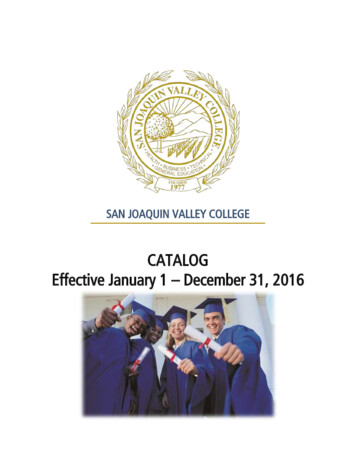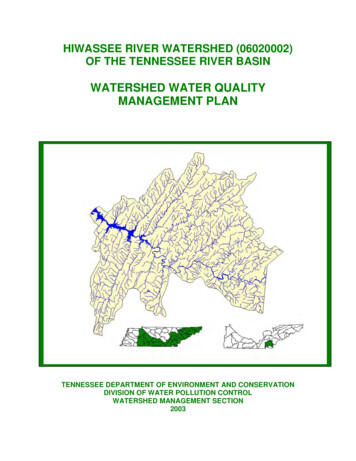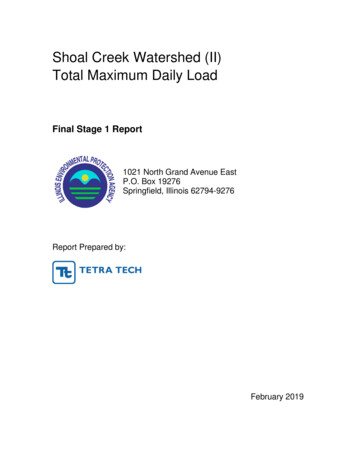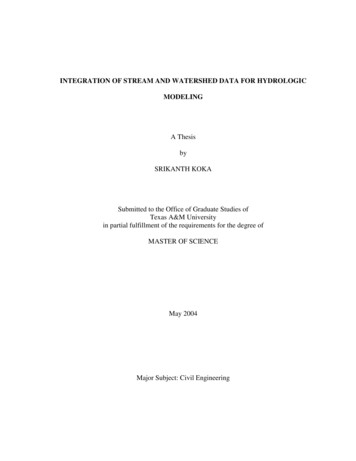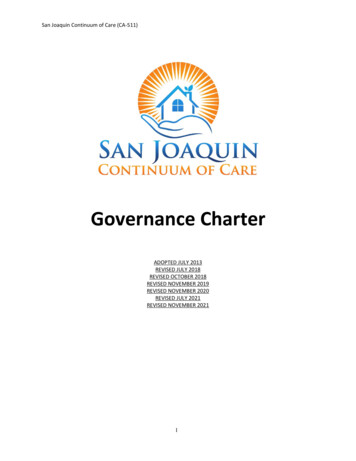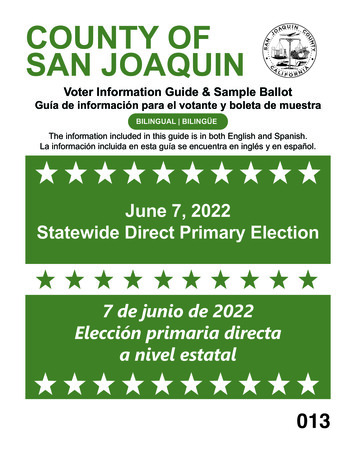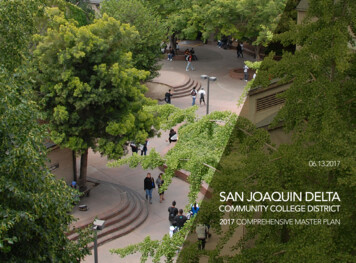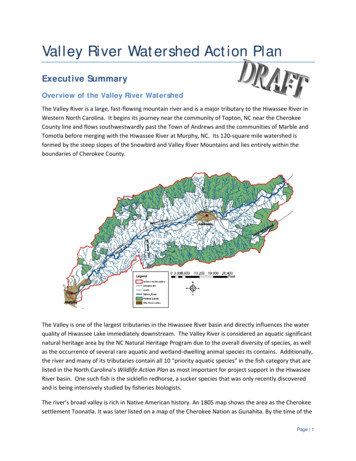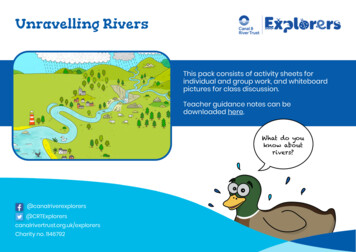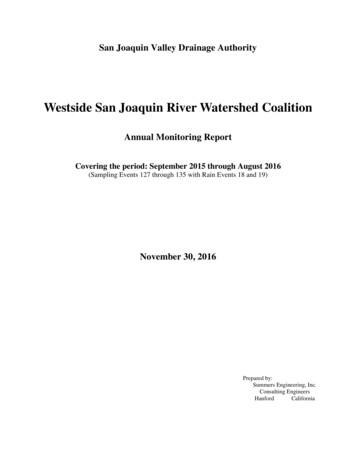
Transcription
San Joaquin Valley Drainage AuthorityWestside San Joaquin River Watershed CoalitionAnnual Monitoring ReportCovering the period: September 2015 through August 2016(Sampling Events 127 through 135 with Rain Events 18 and 19)November 30, 2016Prepared by:Summers Engineering, Inc.Consulting EngineersHanfordCalifornia
Westside San Joaquin RiverWatershed CoalitionAnnual ReportNovember 30, 2016TABLE OF CONTENTSSECTION 1:SECTION 2:SECTION 3:SECTION 4:SECTION 5:SECTION 6:SECTION 7:SECTION 8:SECTION 9:EXECUTIVE SUMMARY . 1COALITION AND MONITORING PROGRAM DESCRIPTION. 3MONITORING EVENT SUMMARIES . 7SAMPLING SITE AND WATERSHED DESCRIPTIONS . 11FIELD SAMPLING PROCEDURE . 18FIELD AND LABORATORY QUALITY CONTROL SAMPLES. 18ANALYTICAL METHODS . 20DATA INTERPRETATION . 20ACTIONS TAKEN TO ADDRESS WATER QUALITYIMPACTS – MANAGEMENT PLAN ACTIVITIES . 24SECTION 10: COMMUNICATION REPORTS . 43SECTION 11: CONCLUSIONS AND RECOMMENDATIONS . 44FIGURESFIGURE 1 . WATERSHED MAP WITH MONITORING SITE LOCATIONSFIGURE 2 .2016 IRRIGATION SEASON PESTICIDE USEFIGURE 2.1 .2016 NON-IRRIGATION SEASON PESTICIDE USEFIGURE 3 . PERCENT OF TOTAL PESTICIDES DETECTEDFIGURE 4 . PERCENT TEST EXCEEDANCES-SPRINGFIGURE 4.1 .PERCENT TEST EXCEEDANCES-FALLFIGURE 5 . AVERAGE SEDIMENT % SURVIVALFIGURE 6 . PERCENT SURVIVAL TREND-SPRING: NORTHFIGURE 7 . PERCENT SURVIVAL TREND-SPRING: SOUTHFIGURE 8 . PERCENT SURVIVAL TREND-FALL: NORTHFIGURE 9 . PERCENT SURVIVAL TREND-FALL: SOUTHATTACHMENTS:ATTACHMENT 1 . SAMPLING EVENT DETAILSATTACHMENT 2 . SIGNIFICANT AQUATIC TOXICITY RESULTSATTACHMENT 3 . FIELD QUALITY CONTROL SAMPLE RESULTSATTACHMENT 4 . SEDIMENT TOXICITY FOLLOW-UP ANALYSESATTACHMENT 5 . EXCEEDANCE OF RECOMMENDED WATER QUALITY VALUESATTACHMENT 6 . MANAGEMENT PLAN ACTIVITIESATTACHMENT 7 . SPECIAL PROJECT MONITORING AND CONSTITUENTSATTACHMENT 8 . WETLAND SUPPLY CHANNEL MONITORING SITESAPPENDICES:APPENDIX A .CHAIN OF CUSTODY SHEETS AND DATA SUMMARYAPPENDIX B . COMMUNICATION REPORTSAPPENDIX C .LABORATORY DATA REPORTS AND EDDSAPPENDIX D . LABORATORY QUALITY ASSURANCE REVIEWAPPENDIX E . SAMPLING EVENT PHOTOSAPPENDIX F.WETLAND WATER QUALITY SUMMARYi
Westside San Joaquin RiverWatershed CoalitionAnnual ReportNovember 30, 2016APPENDIX G . 2015 FARM EVALUATION SURVEYAPPENDIX H . . 2015 NITROGEN MANAGEMENT PLAN SUMMARY REPORTii
Westside San Joaquin RiverWatershed CoalitionAnnual ReportNovember 30, 2016SEMI-ANNUAL MONITORING REPORT REQUIRED COMPONENTSComponent ionSigned Transmittal LetterTitle PageTable of ContentsExecutive SummaryDescription of the Coalition GroupGeographical AreaMonitoring Objectives and DesignSite Descriptions and RainfallRecordsLocation MapTabulation of Analytical ResultsDiscussion of DataManagement Plan Status UpdateSWAMP Comparable EDDSampling and Analytical MethodsLaboratory and Field Quality ControlResultsSummary of Quality AssuranceEvaluation ResultsMethod Used to Obtain FlowSummary of Exceedances andRelated Pesticide Use InformationActions Taken to Address WaterQuality ExceedancesEvaluate monitoring data: identifytemporal/spatial trends/patterns;Summary of Nitrogen ManagementPlan informationSummary of management practiceinformation from Farm EvaluationsSummary of mitigation monitoringSummary of education and outreachactivitiesConclusions and RecommendationsCopies of Chain of Custody SheetsField Data sheets, LaboratoryReports, Laboratory Raw DataMonitoring Site and Event PhotosiReport SectionAttachedCoverTable of ContentsSection 1Section 2Section 2Sections 3 & 4Section 4Appendix ASections 3, 4, 6, 8, & 9,Attachments 1, & 2Section 9, Attachment 6Appendix CSections 2, 5, & 7Section 6, Attachment 3,Appendix DSection 6, Appendix DSection 6Sections 4, 8, Attachments 2 & 5,& Appendix BSection 9Sections 8, 9, Attachment 6, &Appendix GAppendix HAppendix GN/ASection 9, Table 14Section 11Appendix AAppendix CAppendix D
Westside San Joaquin RiverWatershed CoalitionAnnual ReportNovember 30, 2016SECTION 1: EXECUTIVE SUMMARYThis report covers the 2015/2016 growing season sampling events beginning September 2015through August 2016 (Event 127 through Event 134 and Rain Events 18 and 19). Of the 21monitoring sites within the Westside San Joaquin River Watershed Coalition (WestsideCoalition), 18 are located on streams and waterways that are dominated by spring/summeragricultural drainage runoff.The 2016 irrigation season was classified as a critical hydrologic year type for the westside of theSan Joaquin Valley with Federal Water Contractors receiving 5% of federal water contractallocation. There were no significant storms during the report period. See Section 3 for adiscussion of measured rainfall. Monitoring samples were collected at all sites containingsufficient water in accordance with the Westside Coalition’s Monitoring and Reporting Plan 1.Sediment samples were scheduled and collected in September 2015 and April 2016. During theSeptember event sediment toxicity ( 80% survival) was reported at the Blewett Drain, DelPuerto Creek at Cox Road, Hospital Creek at River Road, and Ingram Creek at River Road sites.Sediment toxicity ( 80% survival) during the April 2016 event was reported at the HospitalCreek at River Road, Ingram Creek at River Road, and Orestimba Creek at River Road sites. Theseven sediment samples exhibiting severe toxicity were tested for selected pesticides. SeeSections 8 and 9 for a further discussion of the results.Attachment 1 details the samples collected at each site during each sampling event. A summaryof the monitoring results is presented in Appendix A. During the report period, significantaquatic toxicity was measured once each for Ceriodaphnia dubia and Selenastrumcapricornutum which is summarized in Table 1 below.Table 1: Summary of Aquatic ToxicityEventSiteR18 (January) Marshall Road Drain at River Road134 (August) Poso Slough at Indiana AvenueSpecies% Survival or% Control GrowthSelenastrum capricornutum – 3.8% GrowthCeriodaphnia dubia - 0% SurvivalThese results, along with associated follow up testing, water quality and flow data, aresummarized in Attachment 2. Details of aquatic toxicity analyses are included in Appendix C.Quality control samples were collected in addition to the event analysis sample. The qualitycontrol samples included field blanks, field duplicates, laboratory blanks and spike, and matrixspike/matrix spike duplicate samples (MS/MSD).There were a handful of minor quality control issues, including exceedance of the field duplicaterelative percent difference (RPD) value, and surrogate, matrix spike, or laboratory spikerecoveries outside of the expected range. None of these issues are expected to affect datausability. Results of the Field Quality Control samples are discussed in Section 6 andAttachment 3. A review of laboratory quality assurance activities is included in Appendix D.1Attachment B to Order R5-2014-0002-R2: Monitoring and Reporting Program1
Westside San Joaquin RiverWatershed CoalitionAnnual ReportNovember 30, 2016Table 2 lists the sites that were sampled during the 2015/2016 growing season.Table 2: Collected Samples - September 2015 through August 23Monitoring SiteDischarge SitesHospital Cr at River RoadIngram Cr at River RoadWestley Wasteway near Cox RoadDel Puerto Cr near Cox RoadDel Puerto Cr at Hwy 33Ramona Lake near Fig AvenueMarshall Road Drain near River RoadOrestimba Cr at River RoadOrestimba Cr at Hwy 33Newman Wasteway near Hills Ferry RoadSan Joaquin River at Lander AvenueMud Slough u/s San Luis DrainSalt Slough at Lander AvenueSalt Slough at Sand DamLos Banos Creek at Highway 140Los Banos Creek at China Camp RoadBlewett Drain near Highway 132Poso Slough at Indiana AvenueSource Water SitesSan Joaquin River at Sack DamSan Joaquin River at PID PumpsDelta Mendota Canal at Del Puerto WDEvent 127SeptemberEvent 128 Event R18Event 129Event SSSSSSSSSNPNPNPNF Not sampled due to lack of flow.NP Not included in the sampling plan.NS Not sampled - sample missed.Table 2: Collected Samples - September 2015 through August 2016 oring SiteDischarge SitesHospital Cr at River RoadIngram Cr at River RoadWestley Wasteway near Cox RoadDel Puerto Cr near Cox RoadDel Puerto Cr at Hwy 33Ramona Lake near Fig AvenueMarshall Road Drain near River RoadOrestimba Cr at River RoadOrestimba Cr at Hwy 33Newman Wasteway near Hills Ferry RoadSan Joaquin River at Lander AvenueMud Slough u/s San Luis DrainSalt Slough at Lander AvenueSalt Slough at Sand DamLos Banos Creek at Highway 140Los Banos Creek at China Camp RoadBlewett Drain near Highway 132Poso Slough at Indiana AvenueSource Water SitesSan Joaquin River at Sack DamSan Joaquin River at PID PumpsDelta Mendota Canal at Del Puerto WDAprilSSNFSNPNFSNFNFSSSSSSSSSNotes: S Water sampled according to the MRP.SS Sediment sampled according to the MRP.NA Not sampled due to lack of safe access.MapDesignationEvent 130Event 131 Event 132Event 133Event NFSSSSSSSSSSSSSSSSSSSSS2
Westside San Joaquin RiverWatershed CoalitionAnnual ReportNovember 30, 2016SECTION 2: COALITION AND MONITORING PROGRAM DESCRIPTIONOn February 2, 2014 The San Joaquin Valley Drainage Authority (SJVDA) submitted a Noticeof Intent (NOI) to act as the third-party group to represent growers affected by the WasteDischarge Requirements General Order for Growers within the Western San Joaquin RiverWatershed (Order No.R5-2014-002). With a letter dated March 17, 2014, the Regional WaterQuality Control Board approved the SJVDA NOI. The SJVDA, a joint powers agency, is theumbrella organization for the Westside Coalition.The Westside Coalition watershed generally lies on the west-side of the San Joaquin River fromapproximately the Stanislaus River on the north to 10 miles south of Mendota and encompassesan area of approximately 460,000 acres. There are approximately 4,000 landowners and 1,500operators within the watershed. Most of the watershed receives water supplies from the CentralValley Project, while certain areas receive water from the State Water Project. In addition, someareas receive supplies from the San Joaquin River and local water sources, one area receives aKings River supply, and some areas receive water from groundwater wells. The Delta-MendotaCanal and San Luis Canal run through the watershed. Water deliveries are made to FederalCentral Valley Project Contractors and to San Joaquin River Exchange Contractors from thesefacilities. State water deliveries are also made to one area.The Westside Coalition area also includes federal, state and private managed wetlands. Theseareas share water delivery and drainage conveyance systems with the surrounding agriculturalareas. Due to the integrated nature of the water facilities the managed wetlands have joined theWestside Coalition as a wetland sub-watershed participant to comply with the General Order toeffectively and efficiently address water quality issues. The effects of discharges from thewetland areas are covered in this monitoring program.The communities of Grayson, Westley, Vernalis, Crows Landing, Patterson, Newman, Gustine,Stevinson, Los Banos, Dos Palos, South Dos Palos, Firebaugh, Mendota and Tranquillity liewithin the geographic area of the Westside Coalition. These communities do not havedischarges from irrigated lands and are not included in the Westside Coalition, but contributestorm waters and municipal waste waters to the watershed and may impact discharges fromirrigated lands.Interstate Highway 5, State Highways 33, 140, 165, 152, and many county roads run through thegeographic area of the Westside Watershed. Storm water discharges from these roads andhighways can contribute contaminants to the same water bodies that carry agricultural returnwater.On July 30, 2004, the Westside Coalition received approval for its irrigated agriculturalmonitoring plan from the Central Valley Regional Water Quality Control Board (RegionalBoard). The first sampling event took place on July 6, 2004, with subsequent event samplescollected monthly. In February, 2008, the Westside Coalition received approval for a revisedMonitoring and Reporting Plan (Revised MRP). The Revised MRP was designed to focusmonitoring efforts at sites with known water or sediment issues and to support the ManagementPlan issues. The Revised MRP was implemented in March of 2008. Monitoring and ReportingProgram Order No. R5-2008-0831 (MRP Order or MRP) was issued by the Regional Board in3
Westside San Joaquin RiverWatershed CoalitionAnnual ReportNovember 30, 2016September 2008. This order was largely reflective of the Revised MRP and took effect in March2009, modified after the 2011/12 assessment period. Currently, the Westside Coalition ismonitoring and reporting pursuant to Attachment B to Order R5-2014-0002-R2, which tookeffect January 15, 2015. See Attachment 7.On August 3, 2015, the Westside Coalition, in cooperation with the East San Joaquin WaterQuality Coalition, submitted a request to the Regional Board’s Executive Officer (EO) toparticipate, at the Steering Committee level, in the Delta Regional Monitoring Program (DeltaRMP). The request to the EO proposed a 40,000 per year contribution to the Delta RMP, and inreturn the Westside Coalition would receive a commensurate reduction in its monitoringschedule. On April 17, 2015 the Westside Coalition submitted to the Regional Board a reducedmonitoring 2 proposal; the EO approved the request for a seat on the Steering Committee and thereduced monitoring proposal on October 5, 2015. The Coalition submitted an updatedMonitoring Plan to the Regional Board in January 2016. The 2015/2016 monitoring report isreflective of the newly approved monitoring schedule.On July 16, 2015 the Coalition submitted a proposed revision to the monitoring and reportingplan to account for possible selenium discharges to wetland supply channels in the interfacebetween the Westside Coalition and the Grassland Drainage Area. A revised plan was submitteddate January 15, 2016 and approved by the Regional Board on January 26, 2016 (seeAttachment 8).The current MRP includes a targeted monthly sampling plan for 21 monitoring sites within theCoalition area as well as plans for sampling two rain events during each year. The monitoringsites include 3 source water sites and 18 sites that discharge agricultural drain water.During any given sampling event, each accessible site is visited, visually assessed, and samplesare collected in accordance with the field sampling manual. See Table 2.The objectives of the original monitoring program are: To assess the existing water quality characteristics of major agricultural drains withinthe watershed area. To determine the location and magnitude of water quality problems. To determine the cause of water quality problems and develop solutions.Two sampling crews have been trained by the analytical laboratories to collect samplesaccording to the Westside Coalition’s QAPP and Field Sampling Manual. These crews areresponsible for collecting samples at each of the 21 sites; the field coordinator for the northerlyregion is responsible for collecting samples north of Newman Wasteway. The field coordinatorfor the southerly region is responsible for collecting samples south of (and including) NewmanWasteway. The sampling responsibilities include completion of the field data sheets, collectionof water and sediment samples, completion of labels and chain of custody sheets, andcoordination with the labs for sample pickup. The MRP Sample Regimens at each site areshown in Table 3. The laboratory, method, and constituent groups analyzed are shown in Table4 and a list of specific analytes is included in Attachment 7.2Table 2 outlines the reduced schedule4
Westside San Joaquin RiverWatershed CoalitionAnnual ReportNovember 30, 2016Table 3: Monitoring Stations and Sampling RegimensIrrigationMonitoring SiteDischarge SitesBlewitt Drain Highway 132Poso Slough at Indiana AvenueHospital Creek at River RoadIngram Creek at River RoadWestley Wasteway near Cox RoadDel Puerto Creek near Cox RoadDel Puerto Creek at Hwy 33Ramona Lake near Fig AvenueMarshall Road Drain near River RoadOrestimba Creek at River RoadOrestimba Creek at Hwy 33Newman Wasteway near Hills Ferry RoadSan Joaquin River at Lander AvenueMud Slough u/s San Luis DrainSalt Slough at Lander AvenueSalt Slough at Sand DamLos Banos Creek at Highway 140Los Banos Creek at China Camp RoadSource Water SitesSan Joaquin River at Sack DamDelta Mendota Canal at Del Puerto WDSan Joaquin River at PID PumpsSeason TypeNon-IrrigationRain EventSite Code(Mar-Aug)*(Sep-Feb)*(2x per OCARROCAHWNWHFRSJRLAMSUSLSSALASSASDLBCHWLBCCCCore SpecialSpecialSpecialCore SpecialCore SpecialCore SpecialCore SpecialCore SpecialCore SpecialSpecialCore SpecialCore SpecialCore SpecialCore SpecialSpecialCore SpecialCore SpecialCoreCoreCoreCoreCoreCoreCoreCoreCoreCore SpecialCore SpecialCore SpecialCore ceSourceSourceSourceSourceSourceSource* Irrigation season is defined as March through August. Non-irrigation season is defined as September through February. The Westside Coalition, incollaboration with the Regional Water Quality Control Board, may shift the seasons up or back 1 month to account for actual irrigation practices.5
Westside San Joaquin RiverWatershed CoalitionAnnual ReportNovember 30, 2016ToxicitySediment PesticidesGen. Phy. / D.W.Field DataTable 4: Analytes, Laboratories, and ed OxygenFlowColor itrateNitrogen, NitriteTKNPhosphateAmmonia (as N)DOCTOCFecal coliformE. cidesOrganochlorinePyrethroid% SolidsTOCCeriodaphnia d.LaboratoryField CrewField CrewField CrewField CrewField estCaltestPERSelenastrum c.PERPimephales p.Hyalella a.PERPERMethodEPA �g/Lµg/Lµg/Lmg/kg (dry)mg/kg (dry)%%EPA-821-R-02-012% survivalLaboratory SOP No.Field ManualField ManualField ManualField ManualField EHARD-rev5EM-ICP-rev10E & 1rev8Pyrethroidsrev4aResidue-rev6WalkleyBlack TOCAcute Cerio SOPEPA-821-R-02-013 &EPA-600-4-91-002cell growthChronic Selenastrum SOPEPA-821-R-02-012% survivalEPA-600-R-99-064% survivalAcute FHM SOP10-D HyalellaAcuteSedTestYSI meterYSI meterYSI meterYSI meterEstimateSM 2120BSM 4500-H BSM 2540CSM 2540DSM 2130BEPA 130.2EPA 200.7, 200.8EPA 300.0EPA 354.1EPA 351.3EPA 365.2EPA 350.2SM 5310-B/CSM 5310-B/CSM20-9221B/ESM 9221BF/9223-BEPA 8141A8081A/8082EPA 8321A LLEPA 8141ASW846 8081SW846 8270(SIM)EPA 160.3Caltest Labs in Napa, CaliforniaAPPL Labs in Fresno, CaliforniaPacific EcoRisk (PER) in Fairfield, CaliforniaAquatic toxicity samples were collected and analyzed by Pacific EcoRisk, Inc. using the methodsdescribed below: Ceriodaphnia dubia: “Methods for Measuring the Acute Toxicity of Effluents andReceiving Waters to Freshwater and Marine Organisms” (USEPA 2002a). Pimephales promelas: “Methods for Measuring the Acute Toxicity of Effluents andReceiving Waters to Freshwater and Marine Organisms” (USEPA 2002a). Selenastrum capricornutum: “Short-term Methods for Estimated the ChronicToxicity of Effluents and Receiving Water to Freshwater Organisms” (USEPA2002b). Hyalella azteca: “Methods for Measuring the Toxicity and Bioaccumulation ofSediment-associated Contaminants with Freshwater Organisms” (USEPA 2000).6
Westside San Joaquin RiverWatershed CoalitionAnnual ReportNovember 30, 2016SECTION 3: MONITORING EVENT SUMMARIESMonitoring Event Summaries.Beginning in September 2015 and in accordance with the MRP, monitoring was implemented atthe discharge sites indicated in Table 3 above. The monitoring sites were visited, as scheduled,during the reporting period and samples were collected from the sites with sufficient water (SeeTable 2) to submerge and fill a sample container.Three CIMIS 3 stations were monitored by the Westside Coalition for rainfall: Patterson, LosBanos, and Firebaugh. Table 5 summarizes the monthly rainfall measured at each station.Table 5: Monthly Rainfall in InchesMonthPatterson Los BanosSeptember0.030October0.30.32November2.04 (K)1.79 (K)December0.810.96January4.41 (K)4.19 40.39June00July00August00Report Period Total13.4811.66Firebaugh0 (K 4)0.25 (K)1.69 (K)0.852.990.191.681.121.440.010010.22Rainfall during the 2015/2016 growing season was typical for the western San Joaquin Valleywith no significant storm events occurring.Event 127, September 14 and 15, 2015.Ambient water samples were collected at 13 discharge sites and 3 source water sites onSeptember 15th in accordance with the Westside Coalition MRP. There was insufficient flowfor sample collection at Westley Wasteway near Cox Road, Ramona Lake near Fig Avenue,Orestimba Creek at River Road, and Orestimba Creek at Highway 33 sites. Aquatic toxicity wastested for algae, invertebrates, and fish in accordance with the Monitoring Order (seeAttachment 7).No aquatic toxicity was observed in any of the samples.Sediment samples were collected at 8 monitoring sites on September 14th. Significant toxicitywas observed in the Blewett Drain (1.3% survival) sample, the Hospital Creek sample (0.0%survival), the Ingram Creek sample (0.0% survival), and the Del Puerto Creek at Cox Road3California Irrigation Management Information System, S Site Designations: Patterson – 161; Los Banos – 056; Firebaugh/Telles – 0074“K” flag - One or More Daily Values Flagged as Unreliable.7
Westside San Joaquin RiverWatershed CoalitionAnnual ReportNovember 30, 2016sample (56.3% survival). Sediment from the Blewett Drain, Hospital Creek, Ingram Creek, andDel Puerto Creek at Cox Road samples were sent to Caltest Laboratories for pesticide analysis.In those four sediment samples, pesticides were present in sufficient concentration in all thesamples to have caused the observed toxicity. See Section 8 and Attachment 4.Event 128, October 20, 2015.Ambient water samples were collected at 8 discharge sites and 3 source water sample sites.There was insufficient flow for sample collection at Ingram Creek at River Road, WestleyWasteway near Cox Road, Ramona Lake near Fig Avenue, Marshall Road Drain near RiverRoad, Orestimba Creek at River Road, and Blewett Drain near Highway 132 sites. Aquatictoxicity was tested for algae, invertebrates, and fish in accordance with the Monitoring Order(see Attachment 7).No aquatic toxicity was observed in any of the samples.Rain Event 18, January 7, 2016.Ambient water samples were collected at 9 discharge sites and 3 source water sites. There wasinsufficient flow to collect samples at the Hospital Creek at River Road, Del Puerto Creek nearCox Road, Del Puerto Creek at Hwy 33, Orestimba Creek at River Road, Orestimba Creek atHwy 33, Blewett Drain near Highway 132, and Poso Slough at Indiana Avenue sites. Lack ofsafe access prevented sample collection at the Westley Wasteway near Cox Road, and RamonaLake near Fig Avenue sites. Aquatic toxicity was tested for algae, invertebrates, and fish inaccordance with the Monitoring Order (see Attachment 7).Significant toxicity was observed for Selenastrum capricornutum (3.8% growth) in the MarshallRoad Drain near River Road sample (MRDRR). There was a 50% reduction in Selenastrumgrowth in the MRDRR ambient water sample relative to the corresponding Control treatment. Asper the Coalition’s Quality Assurance Program Plan (QAPP), that triggered the implementationof a Toxicity Identification Evaluation (TIE) targeted for pesticides and metals.Event 129, February 9, 2016.Ambient water samples were collected at 8 monitoring sites and 3 source water sites inaccordance with the Westside Coalition’s MRP. There was insufficient flow for samplecollection at Ingram Creek at River Road, Westley Wasteway near Cox Road, Del Puerto Creeknear Cox Road, Ramona Lake near Fig Avenue, Marshall Road Drain near River Road,Orestimba Creek at River Road, Blewett Drain near Highway 132, and Poso Slough at IndianaAvenue sites for sample collection. Aquatic toxicity was tested for algae, and invertebrates, inaccordance with the Monitoring Order (see Attachment 7).No aquatic toxicity was observed in any of the samples.Rain Event 19, March 8, 2016Ambient water samples were collected at 15 discharge sites and 3 source water sites. Due toinsufficient flow, no samples were collected at the Ramona Lake near Fig Avenue site. Lack ofsafe access prevented sample collection at the Westley Wasteway near Cox Road and Blewett8
Westside San Joaquin RiverWatershed CoalitionAnnual ReportNovember 30, 2016Drain near Highway 132 sites. Aquatic toxicity was tested for algae, invertebrates, and fish inaccordance with the Monitoring Order (see Attachment 7).Foreign algal species were observed at test termination in the Newman Wasteway nearHills Ferry Road, Marshall Road Drain near River Road, and Orestimba Creek at Hwy 33sites. The foreign algal species interfered with the test and prohibited the determination oftoxicity to Selenastrum; the foreign algal species were not observed in the Lab Control.The samples were retested using 0.2 μm filtration with no further foreign algal speciesinterference.No aquatic toxicity was observed in any of the samples.Event 130, March 7, 2016; April 11 and 12, 2016.Ambient water samples were collected at 9 discharge sites and 3 source water sites. There wasinsufficient flow for sample collection at the Hospital Creek at River Road, Westley Wastewaynear Cox Road, Ramona Lake near Fig Avenue, Marshall Road Drain near River Road,Orestimba Creek at River Road, Orestimba Creek at Hwy 33, and Poso Slough at IndianaAvenue. Lack of safe access prevented sample collection at the Blewett Drain near Highway 132site. Aquatic toxicity was tested for algae, invertebrates, and fish in accordance with theMonitoring Order (see Attachment 7).No aquatic toxicity was observed in any of the samples.Sediment samples were collected at 9 monitoring sites; 3 samples on March 7, 2016 and 6samples on April 11, 2016. Significant toxicity was observed in the Hospital Creek at RiverRoad (0.0% survival), Ingram Creek at River Road (0.0% survival), and Orestimba Creek atRiver Road (15.0% survival) sites. In those three sediment samples, pesticides were present insufficient concentration in all the samples to have caused the observed toxicity. See Section 8and Attachment 4.Event 131, May 10, 2016.Ambient water samples were collected at 13 discharge sites and 3 source water sites. There wasinsufficient flow for sample collection at the Ramona Lake near Fig Avenue, Marshall RoadDrain near River Road, Orestimba Creek at River Road, and Orestimba Creek at Hwy 33 sites.Aquatic toxicity was tested for algae, invertebrates, and fish in accordance with the MonitoringOrder (see Attachment 7).No aquatic toxicity was observed in any of the samples.Event 132, June 14, 2016.Ambient water samples were collected at 13 discharge sites and 3 source water sites. There wasinsufficient flow for sample collection at the Ramona Lake near Fig Avenue, Marshall RoadDrain near River Road, Orestimba Creek at River Road, and Orestimb
Westside San Joaquin River Annual Report Watershed Coalition November 30, 2016 3 . SECTION 2: COALITION AND MONITORING PROGRAM DESCRIPTION . On February 2, 2014 The San Joaquin Valley Drainage Authority (SJVDA) submitted a Notice of Intent (NOI) to act as the thirdparty group to represent growers affected by the Waste -
